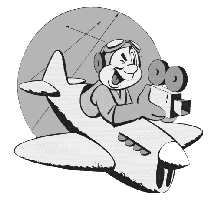The Denver Branch, Air Corps Technical School, was formed in 1937 with Departments of Photography and Armament at Aurora, Colorado was abutted by Lowry Army Air Field in 1938. The Photographic Department staff consisted of 54 enlisted men and 6 officers, with 60 students in attendance. The Armament Department had 100 enlisted men and 10 officers, with 170 students.
The first of the school’s B-18 Bolo bombers had arrived at nearby Denver Municipal (StapletonInternational) Airport. With all the component parts in place, the school’s first classes began at 0800 on the morning of Monday, 28 February 1938, with events being somewhat disrupted by one of the Field’s training aircraft dropping the first load of bombs on the auxiliary landing field six miles east of the main base. The first photographic studies class of 10 men, nine Army Air Corps soldiers and a Marine, that began and completed a course at Lowry Field graduated on June 29th, 1938.
CCU TRAINING
by Al Saldarini (dec.)
1st Combat Camera Unit, 450th BmGp, 15th AF;
(shared with his encouragement and permission)

After a thorough indoctrination at Denver on cameras, volunteers for combat crews were shipped to California and assigned to the First Motion Picture Unit. There they were trained by Hollywood professionals to use many motion picture cameras. Both 16 and 35 millimeter units were used, while the 35 mm was the general standard. For sound movies, some Mitchell studio cameras were used, but the most ubiquitous machine was the 35 mm EYEMO. This was a handheld cine unit, used to film most of the war documentaries you've seen.
The F.M.P.U. (pronounced 'fum-poo') was in a "rough" area, Beverly Hills, where if you peered through the trees you could spot Errol Flynn's and Rudy Vallee's homes. Judo was a daily 3 hour exercise and many of us had persistent headaches for that time. Our instructor, Orun Haglund, I was told, was an Olympic champion. The trail to get to the camp was called Laurel Canyon Drive, and we did it quite often from Culver City to the Boy Scout camp. It was a fair hike with full packs and a continuous Queen Anne drill show for the amused locals.
I know it sounds like a picnic for the most part, but our combat courses, particularly under our leader, the physically rugged Major Reagan, left many a husky GI completely bushed. A few, less rugged individuals passed out from the demanding combat exercises. Marines may have had a more rugged course, but not the infantry; I had already been through that.
Flight physicals, whirling chairs, depth perception, eye charts (Some memorized by anxious recruits like myself), and a series of arm wrenching shots qualified them for flights above 30,000 feet. Col. Paul Mantz would take them on hair-raising aerobatic flights designed to get them used to keeping fighters in the Eyemo camera viewfinder, only in this case it was the Mount Wilson Observatory that stayed still and camera men who did the gyrating. Tours in the decompression chambers at Santa Anna and these aerobatic flights eventually qualified many men to operate a 35mm motion picture camera and hold it on target to record aerial combat, which they did in all theaters of the war.
Combat camera units generally comprised 23 men and officers, 15 of which were on combat/flying status. Camera repair men were equally important, keeping the delicate cameras in running order. At high altitudes the oil in cameras congealed to stone, a fact all-to-apparent to the cold, weary cameramen on his return home. If you flew as a substitute gunner, time passed; otherwise you worried about your films.
Not all combat cameramen returned home. As a matter of fact, the cameramen suffered the highest percentage of casualties of any specialty in World War II.
View the Army Air Forces documentary showing the functions of the Army Air Corps' First Motion Picture Unit, which made training and inspirational films for the Army Air Force during the Second World War.
